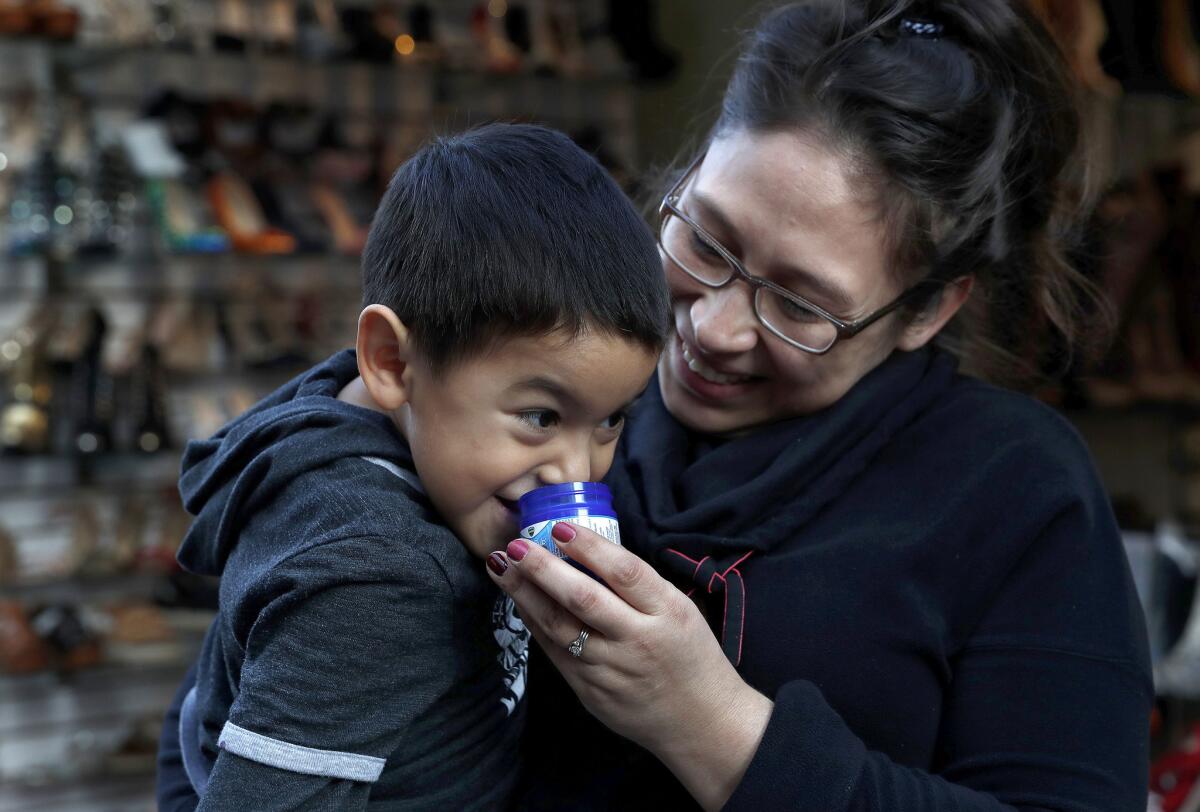Column One: ‘Vivaporu’: For many Latinos, memories of Vicks VapoRub are as strong as the scent of eucalyptus

Many people have memories of Vicks VapoRub from childhood. But for many Latinos, the gooey salve is close to legendary. Here are a few of their stories.
- Share via
They call it Bibaporru, Beep Vaporú, El Bic, El Bix, El Vickisito.
And many think of the sticky, stinky menthol goop as their own, even though it’s used around the world.
In the Latino community, Vicks VapoRub inspires a curious, nostalgic devotion — for its many nicknames and uses far more creative than relief for the common cold and muscle pain.
“If I say to someone, ‘Hey, bring me El Vah-po-ru!’ they’ll know exactly what I'm talking about,” said Luciano Roldan, 78, of El Sereno, who has been rubbing VapoRub all over, including up his nose, since he was a kid in the countryside of El Salvador.
Since the ointment was invented as a croup and pneumonia cure by a North Carolina pharmacist more than a century ago, many have relied on the little blue jar to solve all sorts of problems: athlete’s foot, stretch marks, stomach aches, earaches. Some telenovela actors even rub it on their eyes to bring about tears. Others scoop it into their coffee or their tea.
Online, there are countless tributes to its mighty powers. Some testimonials are real, some are jokes — meant to mimic and spoof those with limitless faith.
Latinos have created vivaporu hashtags, memes, emojis, comedy skits and, for those still scratching their heads at the love affair, explanatory videos. Some have written about their nostalgia in dissertations, poems and published essays.
Others have dressed up as the iconic Vicks container for Halloween or celebrated mom’s birthday with a cake in its image.
You can buy T-shirts, paintings, pins, candles and greeting cards — all featuring the little blue jar.
Mysterious rash? Vivaporu!
Broken arm? Vivaporu!
Broken heart? Put Vivaporu on that, too.
When “Hamilton” creator Lin-Manuel Miranda tweeted a selfie from Puerto Rico in January, holding a tub of Vicks (“I knew I wouldn’t get through the nine show week without peak remedies”), the response was exuberant:
abuelitas everywhere are cheering for this post
That is the brownest thing I’ve ever seen you say.
Nothing like that Veevapuruuú.
‘If I say to someone, “Hey, bring me El Vah-po-ru!” they’ll know exactly what I'm talking about.’
— Luciano Roldan of El Sereno
In 2017, a man who was accused of attempting to sell 2,000 containers of fake Vicks VapoRub across Illinois and Wisconsin did not escape attention.
Carlos Barraza, 23, was charged with violating the Trademark Counterfeiting Act after he got busted at a store called Dos Hermanos in a little town south of Chicago.
“Blasphemy!” declared Latina magazine. “We don't know how Barraza pulled this off. … Be careful out there, folks.”
Of course, not everyone is a fan.
Some people can’t stand the smell or carry clammy memories of catching a cold.
Daniel Olivas, 59, doesn't recall protesting as a kid.
Each time he caught a cold, his mother would slather his chest with the salve as if she were icing a birthday cake, then put him to bed in a haze of eucalyptus.
“I would just succumb to it,” said Olivas, now a lawyer and writer.
He thinks his mom used VapoRub because it was affordable.
“Moms had to come up with ways to heal the family,” he said.

Growing up in Connecticut, Michael Diaz remembers his Dominican parents put VapoRub on acne, scrapes, cuts, bruises. They kept the jar on the dresser in their bedroom.
When he was in second grade, Diaz came home on a snowy day. Just as he had reached his family’s porch, a sharp icicle broke off the gutter and landed straight on his head.
His mom saw the bloody gash and started crying. His dad, Jose, raced to grab the Vivaporu.
He slathered a big chunk of goo on his son’s head and told him, “Hey, you’ll be fine.”
For three days, Diaz went to school smeared with menthol and eucalyptus.
“I had this cold, waxy Vivaporu sandwich on top of my little fro,” he said.
Years later, Diaz, who’s now a freelance producer in New York, was amused to find that so many other Latinos he knew — Dominicans, Puerto Ricans, Colombians — had VapoRub stories.
In 2012, he and a few friends decided to make a Vivaporu rap video and upload it on YouTube.
In it, Diaz’s alter ego Juan Bago and his partner O make miracles happen as they hit the streets of New York City. With the blue jar, they help a blind man see, a paralyzed boy walk, a man heal from a gunshot wound.
You injury prone
Put on the vaporu
Man, we so immune right now
We got vivaporu!
Julia Longoria only started pondering the Vicks phenomena after she grew up and began thinking back on her childhood. In 2017, the WNYC radio reporter and producer decided to dig into the topic a little.
She interviewed dozens of people, but in the end found the best tale right at home: with her Cuban grandmother.
Malvina Camejo, 82, of Palm Beach Gardens, Fla., loves Vicks VapoRub so much she affectionately calls it her Vickisito.
She’s used it for toenail fungus, to strengthen her nails, condition her hair and moisturize her skin. Sometimes she has five or six of the jars on her vanity.
“Anytime any of the cousins got sick, they were like, ‘Don’t tell grandma!’ She’s going to put that all over you.”
Longoria always thought her abuela’s use of VapoRub was an American thing.
But in interviews she learned that her grandma loved the ointment because it took her back to Cuba, to the happy days before the revolution when her own mother used to rub the salve on her in the comfort of her little pink bedroom.
After the embargo cut off the conduit to American products, Longoria’s grandma couldn’t get her Vickisito for years.
In Greensboro, N.C., there are several homages to Lunsford Richardson, the pharmacist whose salve caught on and spread.
Richardson invented a lot of remedies in the 1890s, but the one that clicked was Vicks Magic Croup Salve, created to help people breathe better when they had colds. (His son later came up with VapoRub.)
Old advertising spoke of the “Romance of the Little Blue Jar” with ingredients from “strange, far-distant lands”: menthol from Japan, camphor from the jungles of Formosa, “still the haunt of untamed, savage head-hunters.”
Richardson’s traveling salesmen would post ads on barns, trees and automobiles. At rural drugstores, they’d scoop the salve onto a spoon and have pharmacists inhale the vapors.
“He wanted Vicks to spread all over the world,” Sion Boney, a former company vice president, said of his great-grandfather.
In 1918, the Spanish flu sent sales soaring, from $900,000 to $2.9 million in a single year. Ironically, Richardson was one of the thousands who died in the epidemic.
His company went on to market the ointment in England, Mexico and Central and South America, then dozens of other countries. In the 1920s, Vicks salesmen went door to door handing out coupons in small towns in Bolivia.
In the summer when sales would dip for the cold remedy, Vicks placed ads in newspapers promoting alternative uses: boils, bee stings, frostbite, headaches, poison oak, even distemper in horses.
Some people still hold that Vicks VapoRub helps in those cases.
Behind the story: Hunting for the mystique behind ‘Beep Vaporú’ »
Procter & Gamble, now its parent company, did not return requests for comment, but the company website and Vicks hotline emphasize that users stick to the recommended uses listed on the label.
That means don’t heat it, don’t eat it, don’t stick it up your nose, in your eyes, in your hair, in your ears or other intimate areas — and don’t use it on pets or kids younger than 2.
For coughs, simply rub it on your chest and throat. For muscle and joint pain, rub it in wherever it hurts three to four times daily.
Maybe it was all the advertising. Maybe it was product loyalty. Maybe it was simply a tradition passed from one generation to the next.
When Longoria asked scholars about the fascination with VapoRub, one suggested the subject might make a good doctoral dissertation.
Rachel Herz, a cognitive neuroscientist at Brown University, thinks its strong scent might play a role. She’s included the product in several studies about the powerful memories that smells evoke. She said VapoRub often brought up flashbacks that were positive, “not of feeling sick, but of being cared for and being soothed.”
Daniel Olivas made sure that when he left for college back in the 1970s, he took his VapoRub with him.
But when he rubbed the cream on his chest just as his mother always had done, it didn’t feel the same.
With her, he said, it had been “almost a religious ritual.”
Without her, that magic was gone.
Para leer esta nota en español, haga clic aquí.
Sign up for Essential California
The most important California stories and recommendations in your inbox every morning.
You may occasionally receive promotional content from the Los Angeles Times.








